Common errors in writing journals of the englishmajor students at ho chi minh city open university
Students’ writing problems are always a primary concern of instructors in writing
classrooms, and to know the common errors which frequently occur on students’ writing papers
is usually what the writing instructors have conducted in the classrooms. However, no research
study has been conducted at the Faculty of Foreign languages at HCMC Open University to
investigate into this aspect. The purpose of the current study is to investigate the common written
errors on students’ writing journals and to see whether the extensive writing helps enhance
students’ writing fluency. 115 first year English-major students participated in this study. They
composed five writing journals every week during the course of 15 weeks. Each student
composed 62 writing journals in total. The study found that four most common errors frequently
occur in students’ writing journals are relating to tenses, collocations, spellings, and verb forms.
Also, the current study confirms that the extensive writing practices effect the students’ writing
fluency in terms of length of writing. The results of the study help the writing instructors at the
local setting with the facts of their students’ writing problems in order to improve the writing
practices in the writing classrooms. Particularly, the finding of this study confirms the effects of
extensive writing so that the instructors and students could take this issue into their practices
beyond the classrooms
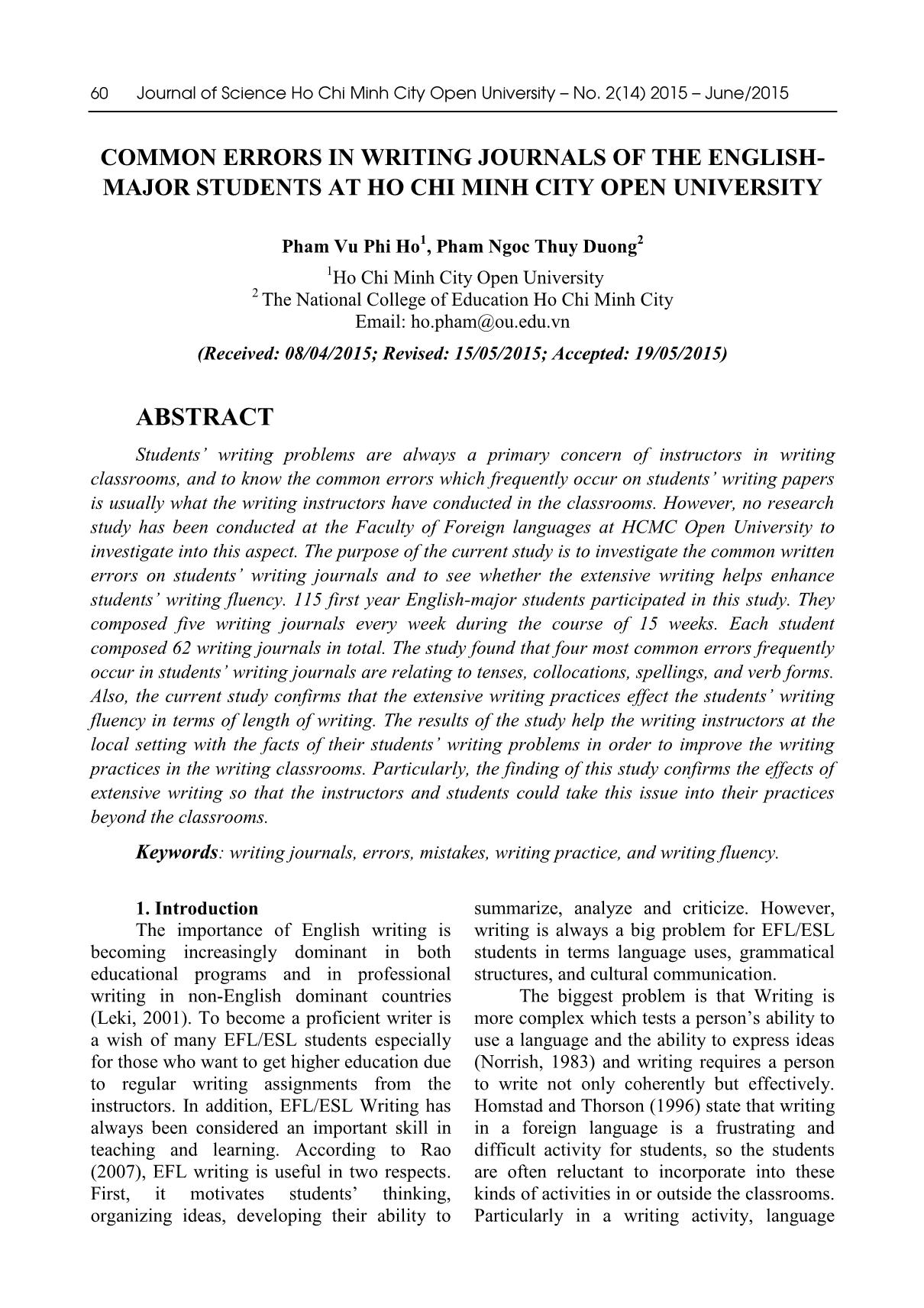
Trang 1
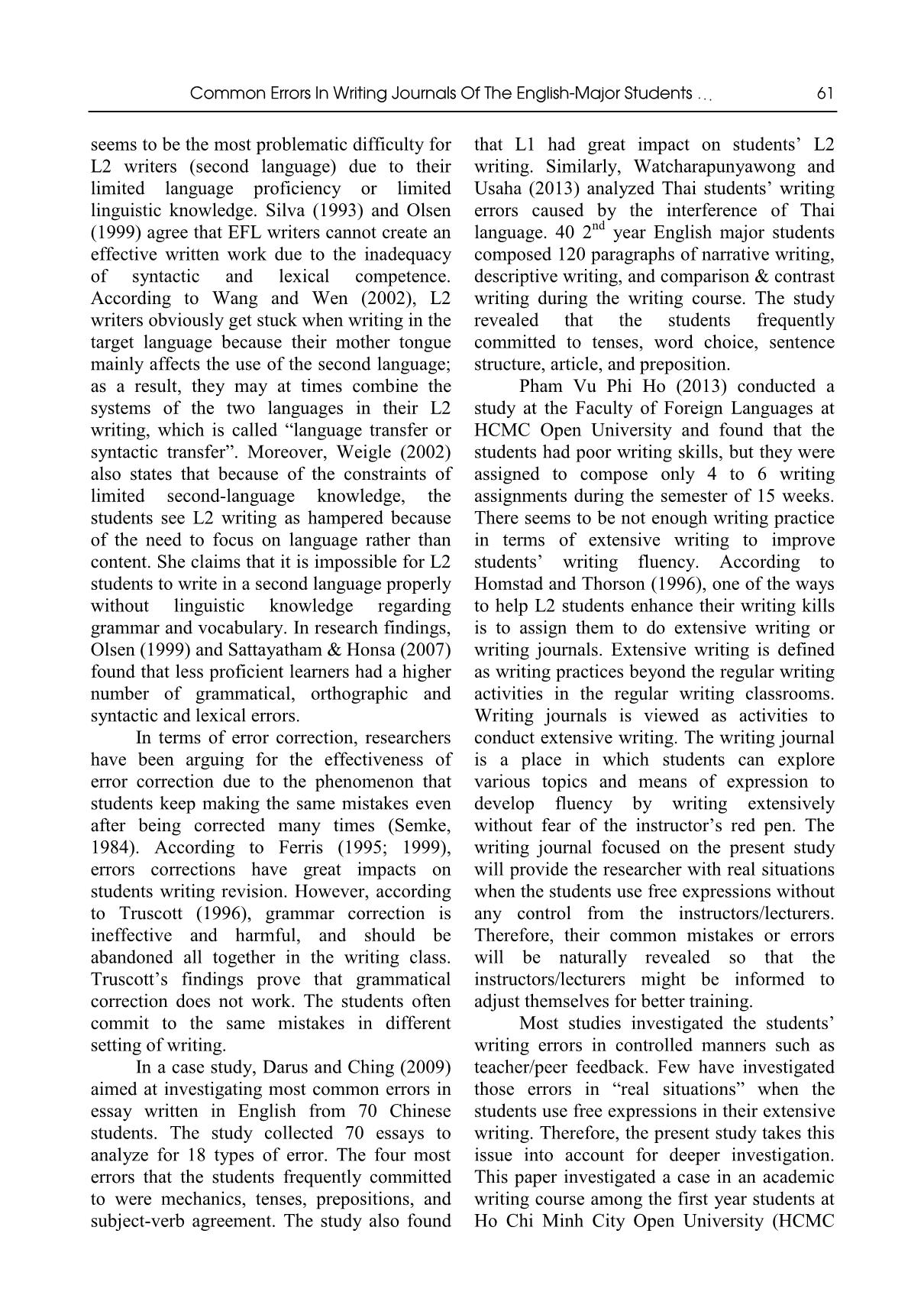
Trang 2
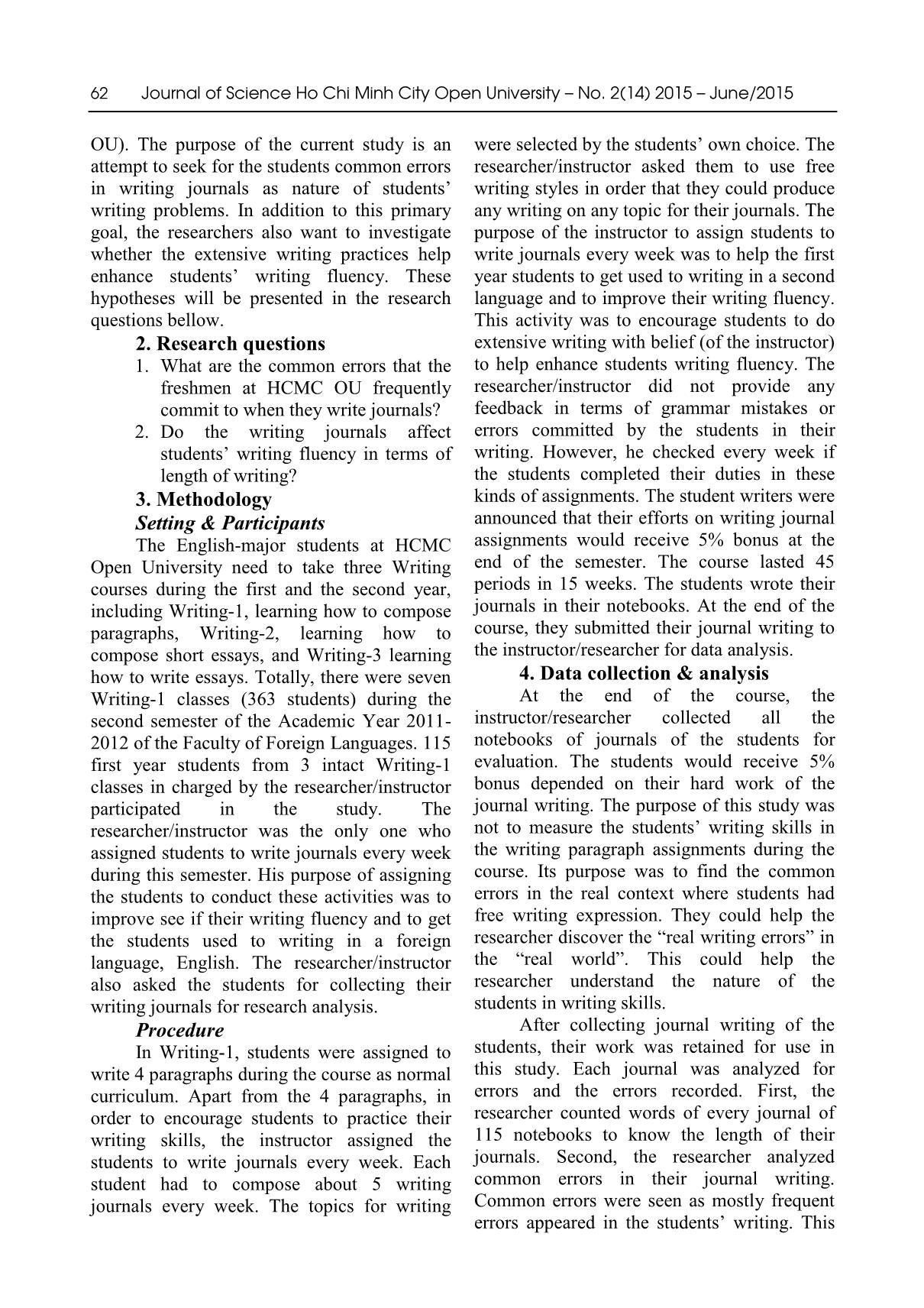
Trang 3
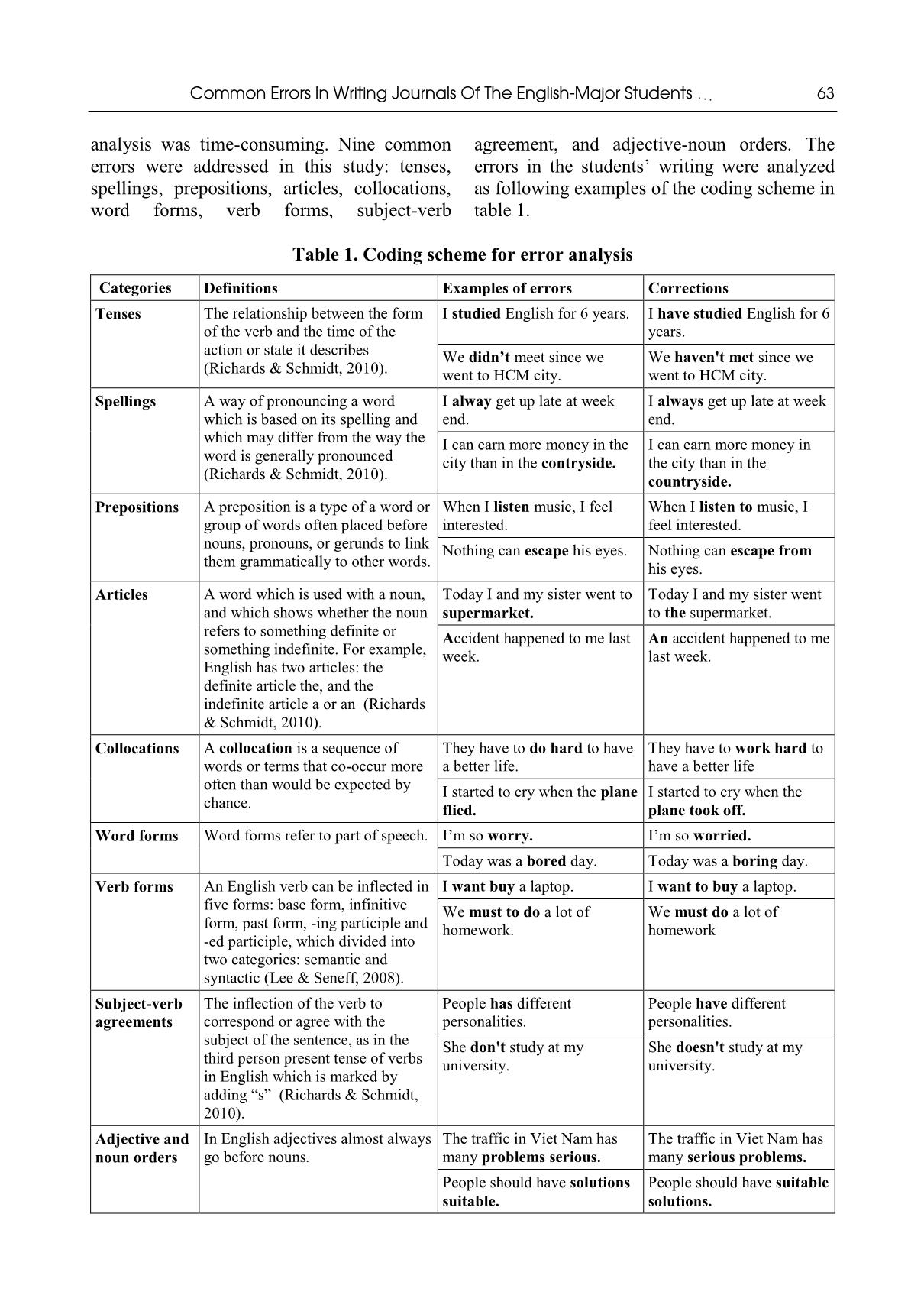
Trang 4
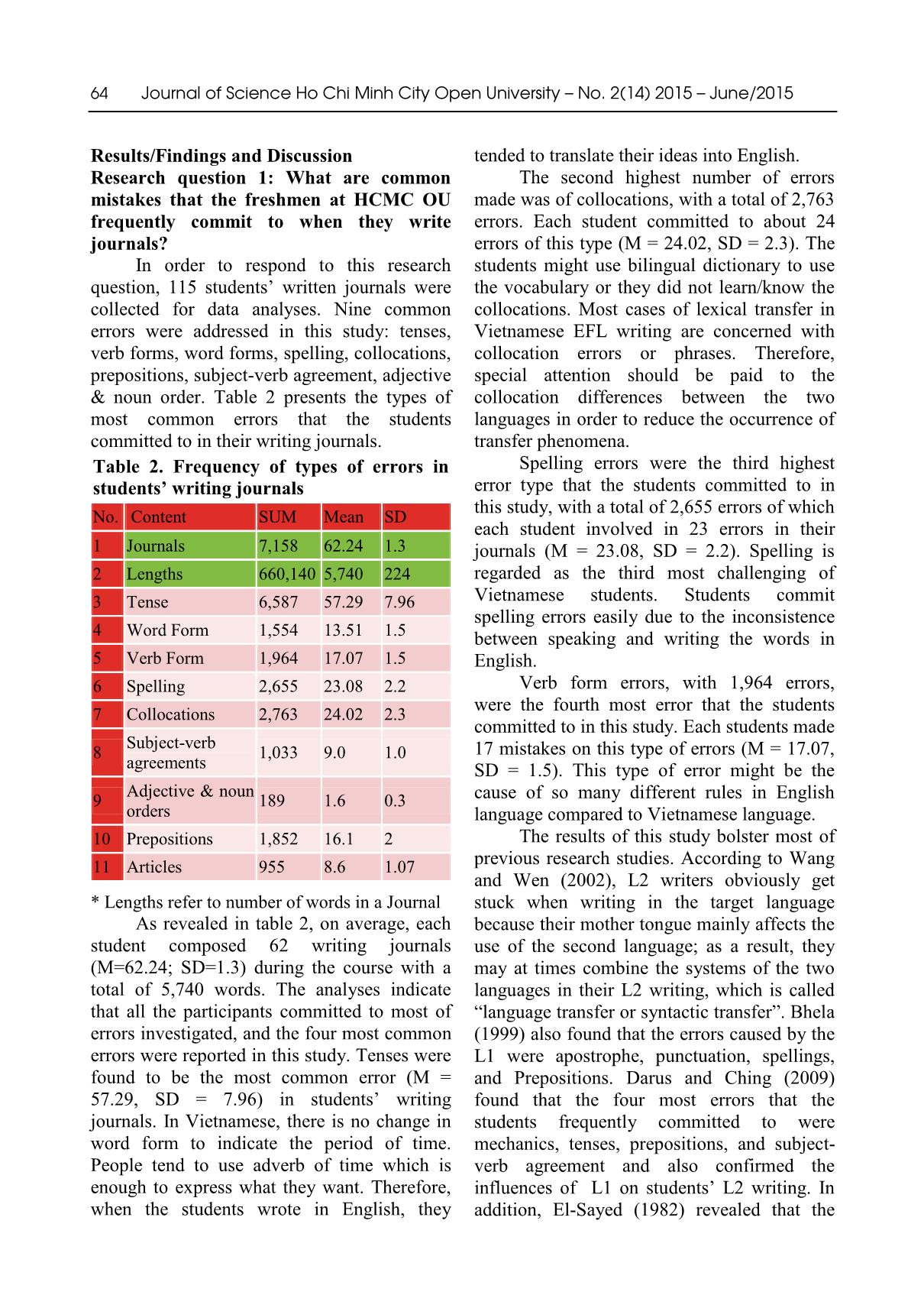
Trang 5
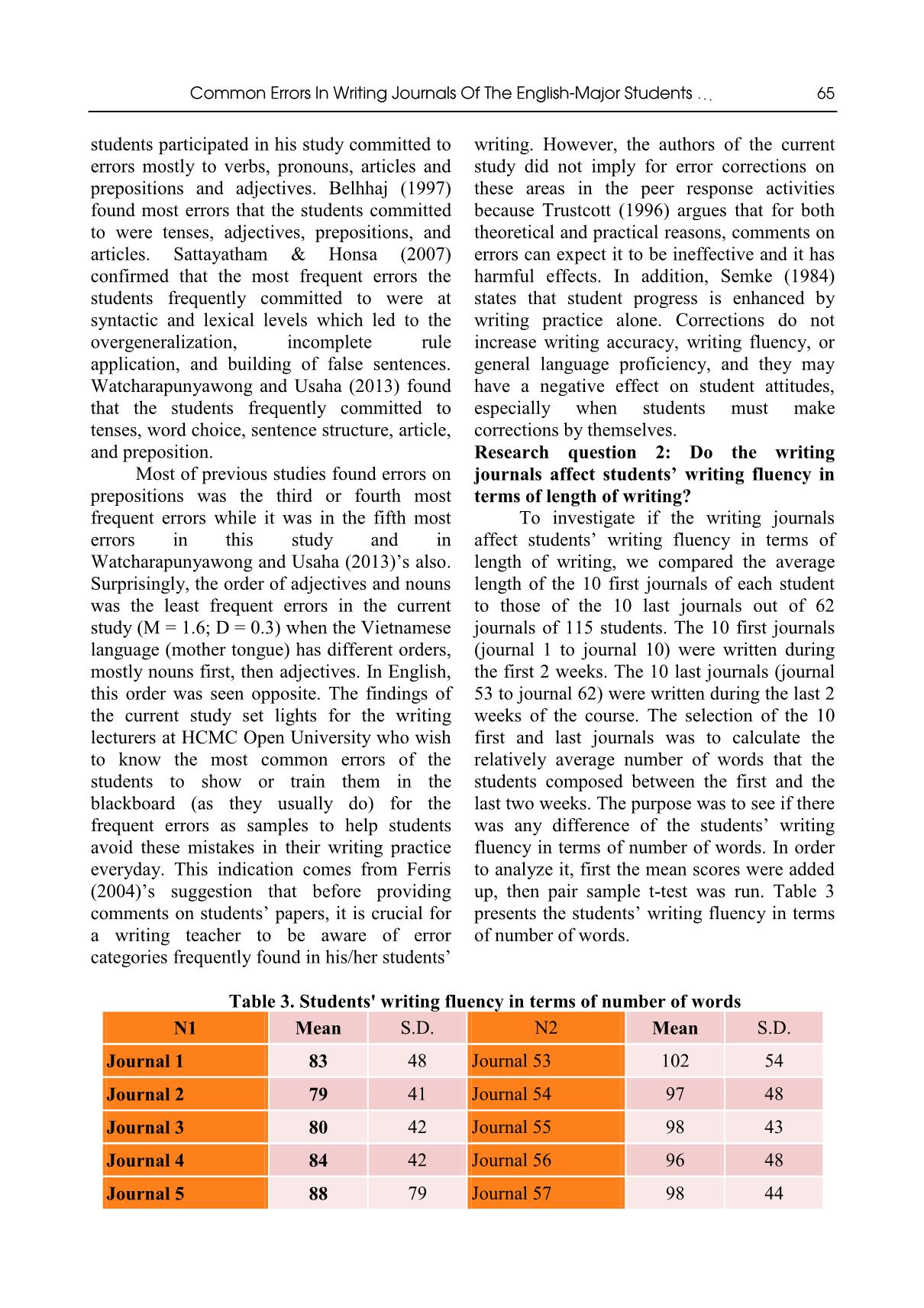
Trang 6
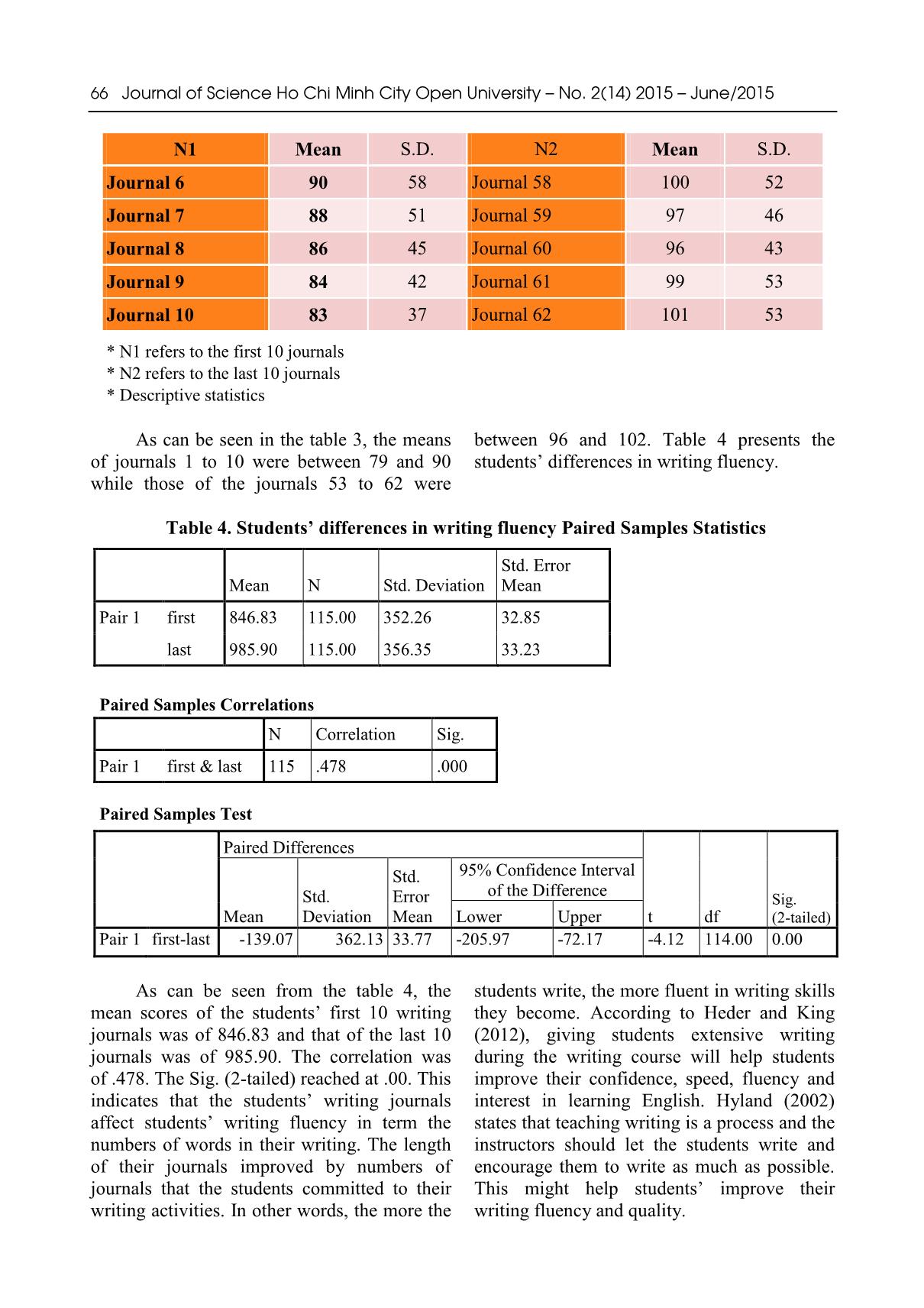
Trang 7
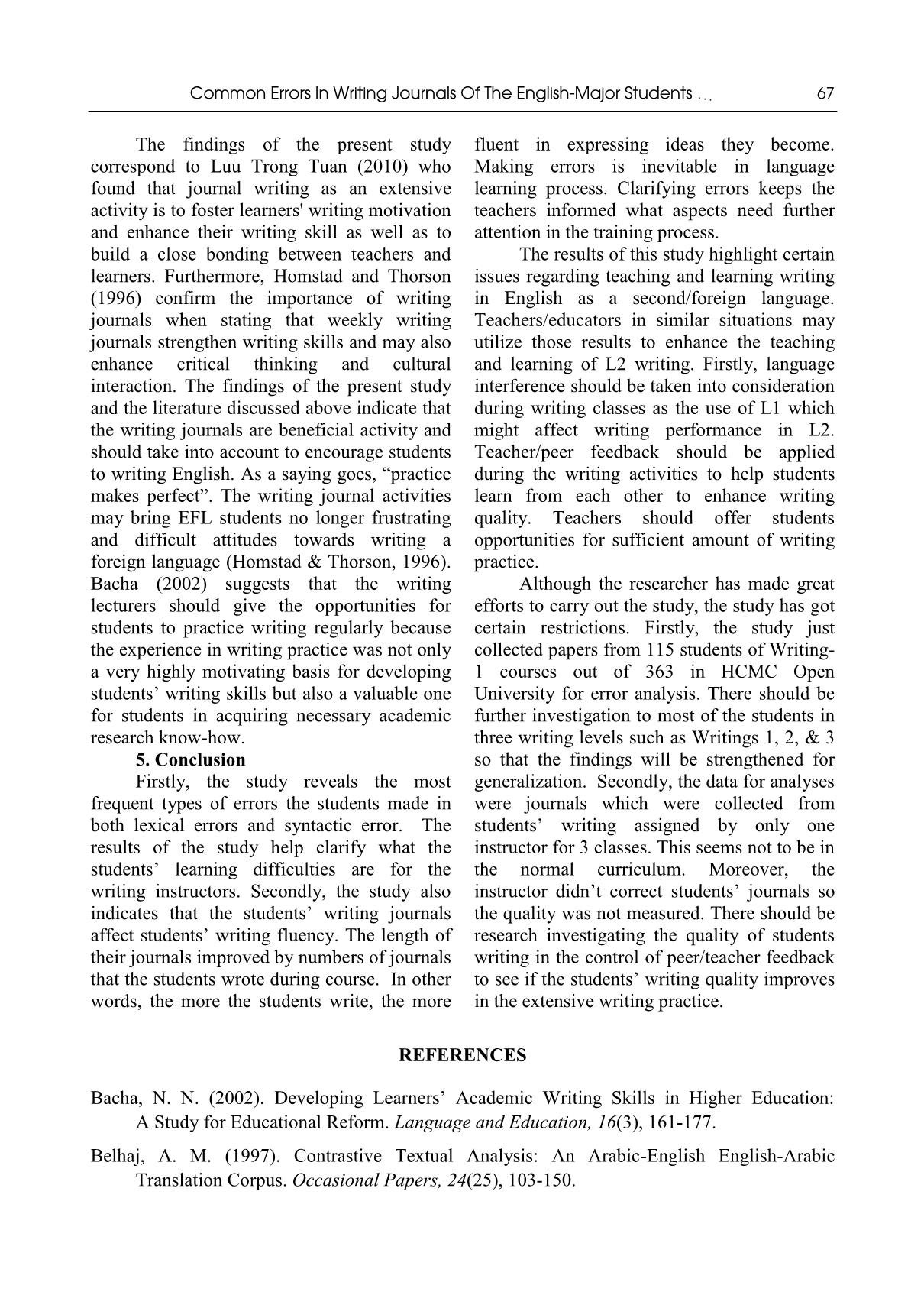
Trang 8
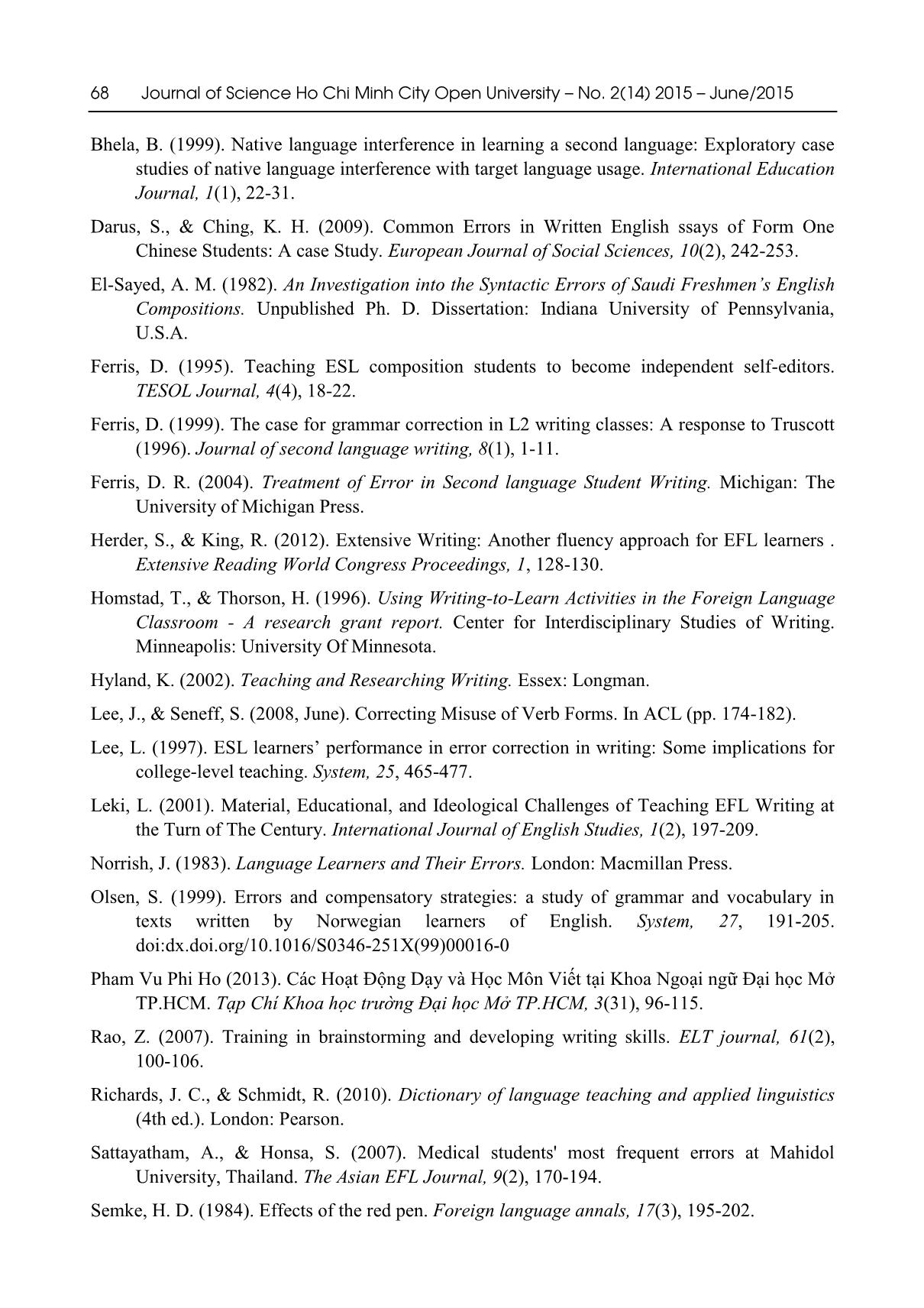
Trang 9
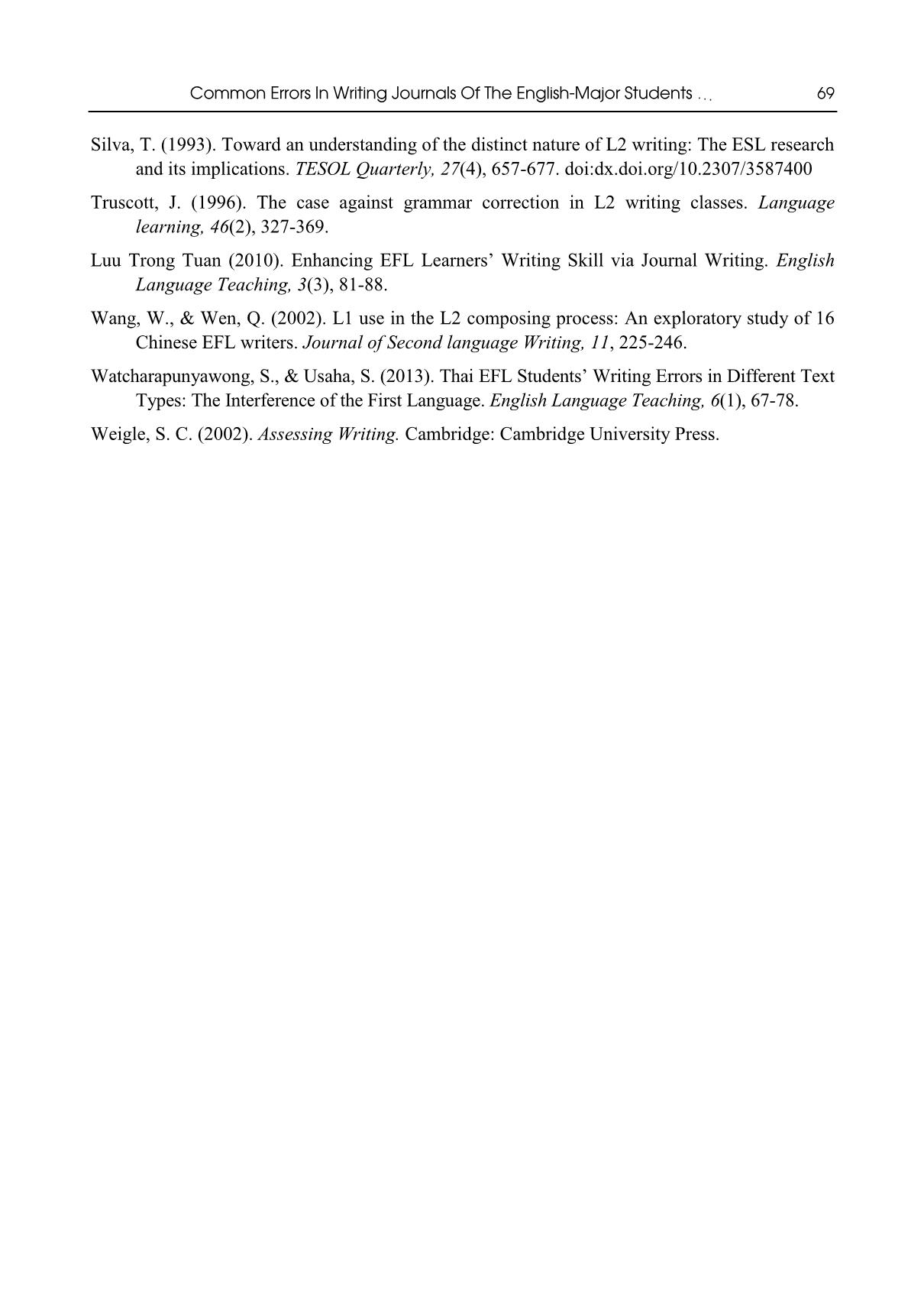
Trang 10
Tóm tắt nội dung tài liệu: Common errors in writing journals of the englishmajor students at ho chi minh city open university
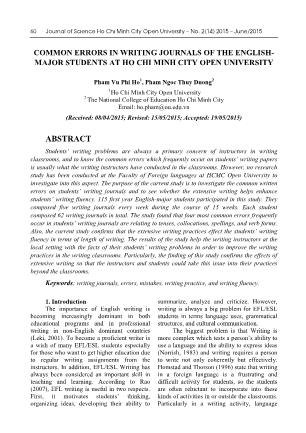
60 Journal of Science Ho Chi Minh City Open University – No. 2(14) 2015 – June/2015 COMMON ERRORS IN WRITING JOURNALS OF THE ENGLISH- MAJOR STUDENTS AT HO CHI MINH CITY OPEN UNIVERSITY Pham Vu Phi Ho 1 , Pham Ngoc Thuy Duong 2 1 Ho Chi Minh City Open University 2 The National College of Education Ho Chi Minh City Email: ho.pham@ou.edu.vn (Received: 08/04/2015; Revised: 15/05/2015; Accepted: 19/05/2015) ABSTRACT Students’ writing problems are always a primary concern of instructors in writing classrooms, and to know the common errors which frequently occur on students’ writing papers is usually what the writing instructors have conducted in the classrooms. However, no research study has been conducted at the Faculty of Foreign languages at HCMC Open University to investigate into this aspect. The purpose of the current study is to investigate the common written errors on students’ writing journals and to see whether the extensive writing helps enhance students’ writing fluency. 115 first year English-major students participated in this study. They composed five writing journals every week during the course of 15 weeks. Each student composed 62 writing journals in total. The study found that four most common errors frequently occur in students’ writing journals are relating to tenses, collocations, spellings, and verb forms. Also, the current study confirms that the extensive writing practices effect the students’ writing fluency in terms of length of writing. The results of the study help the writing instructors at the local setting with the facts of their students’ writing problems in order to improve the writing practices in the writing classrooms. Particularly, the finding of this study confirms the effects of extensive writing so that the instructors and students could take this issue into their practices beyond the classrooms. Keywords: writing journals, errors, mistakes, writing practice, and writing fluency. 1. Introduction The importance of English writing is becoming increasingly dominant in both educational programs and in professional writing in non-English dominant countries (Leki, 2001). To become a proficient writer is a wish of many EFL/ESL students especially for those who want to get higher education due to regular writing assignments from the instructors. In addition, EFL/ESL Writing has always been considered an important skill in teaching and learning. According to Rao (2007), EFL writing is useful in two respects. First, it motivates students’ thinking, organizing ideas, developing their ability to summarize, analyze and criticize. However, writing is always a big problem for EFL/ESL students in terms language uses, grammatical structures, and cultural communication. The biggest problem is that Writing is more complex which tests a person’s ability to use a language and the ability to express ideas (Norrish, 1983) and writing requires a person to write not only coherently but effectively. Homstad and Thorson (1996) state that writing in a foreign language is a frustrating and difficult activity for students, so the students are often reluctant to incorporate into these kinds of activities in or outside the classrooms. Particularly in a writing activity, language Common Errors In Writing Journals Of The English-Major Students 61 seems to be the most problematic difficulty for L2 writers (second language) due to their limited language proficiency or limited linguistic knowledge. Silva (1993) and Olsen (1999) agree that EFL writers cannot create an effective written work due to the inadequacy of syntactic and lexical competence. According to Wang and Wen (2002), L2 writers obviously get stuck when writing in the target language because their mother tongue mainly affects the use of the second language; as a result, they may at times combine the systems of the two languages in their L2 writing, which is called “language transfer or syntactic transfer”. Moreover, Weigle (2002) also states that because of the constraints of limited second-language knowledge, the students see L2 writing as hampered because of the need to focus on language rather than content. She claims that it is impossible for L2 students to write in a second language properly without linguistic knowledge regarding grammar and vocabulary. In research findings, Olsen (1999) and Sattayatham & Honsa (2007) found that less proficient learners had a higher number of grammatical, orthographic and syntactic and lexical errors. In terms of error correction, researchers have been arguing for the effectiveness of error correction due to the phenomenon that students keep making the same mistakes even after being corrected many times (Semke, 1984). According to Ferris (1995; 1999), errors corrections have great impacts on students writing revision. However, according to Truscott (1996), grammar correction is ineffective and harmful, and should be abandoned all together in the writing class. Truscott’s findings prove that grammatical correction does not work. The students often commit to the same mistakes in different setting of writing. In a case study, Darus and Ching (2009) aimed at investigating most common errors in essay written in English from 70 Chinese students. The study collected 70 essays to analyze for 18 types of error. The four most errors that the students frequently committed to were mechanics, tenses, prepositions, and subject-verb agreement. The study also found that L1 had great impact on students’ L2 writing. Similarly, Watcharapunyawong and Usaha (2013) analyzed Thai students’ writing errors caused by the interference of Thai language. 40 2 nd year English major students composed 120 paragraphs of narrative writing, descriptive writing, and comparison & contrast wr ... nd Prepositions. Darus and Ching (2009) found that the four most errors that the students frequently committed to were mechanics, tenses, prepositions, and subject- verb agreement and also confirmed the influences of L1 on students’ L2 writing. In addition, El-Sayed (1982) revealed that the Common Errors In Writing Journals Of The English-Major Students 65 students participated in his study committed to errors mostly to verbs, pronouns, articles and prepositions and adjectives. Belhhaj (1997) found most errors that the students committed to were tenses, adjectives, prepositions, and articles. Sattayatham & Honsa (2007) confirmed that the most frequent errors the students frequently committed to were at syntactic and lexical levels which led to the overgeneralization, incomplete rule application, and building of false sentences. Watcharapunyawong and Usaha (2013) found that the students frequently committed to tenses, word choice, sentence structure, article, and preposition. Most of previous studies found errors on prepositions was the third or fourth most frequent errors while it was in the fifth most errors in this study and in Watcharapunyawong and Usaha (2013)’s also. Surprisingly, the order of adjectives and nouns was the least frequent errors in the current study (M = 1.6; D = 0.3) when the Vietnamese language (mother tongue) has different orders, mostly nouns first, then adjectives. In English, this order was seen opposite. The findings of the current study set lights for the writing lecturers at HCMC Open University who wish to know the most common errors of the students to show or train them in the blackboard (as they usually do) for the frequent errors as samples to help students avoid these mistakes in their writing practice everyday. This indication comes from Ferris (2004)’s suggestion that before providing comments on students’ papers, it is crucial for a writing teacher to be aware of error categories frequently found in his/her students’ writing. However, the authors of the current study did not imply for error corrections on these areas in the peer response activities because Trustcott (1996) argues that for both theoretical and practical reasons, comments on errors can expect it to be ineffective and it has harmful effects. In addition, Semke (1984) states that student progress is enhanced by writing practice alone. Corrections do not increase writing accuracy, writing fluency, or general language proficiency, and they may have a negative effect on student attitudes, especially when students must make corrections by themselves. Research question 2: Do the writing journals affect students’ writing fluency in terms of length of writing? To investigate if the writing journals affect students’ writing fluency in terms of length of writing, we compared the average length of the 10 first journals of each student to those of the 10 last journals out of 62 journals of 115 students. The 10 first journals (journal 1 to journal 10) were written during the first 2 weeks. The 10 last journals (journal 53 to journal 62) were written during the last 2 weeks of the course. The selection of the 10 first and last journals was to calculate the relatively average number of words that the students composed between the first and the last two weeks. The purpose was to see if there was any difference of the students’ writing fluency in terms of number of words. In order to analyze it, first the mean scores were added up, then pair sample t-test was run. Table 3 presents the students’ writing fluency in terms of number of words. Table 3. Students' writing fluency in terms of number of words N1 Mean S.D. N2 Mean S.D. Journal 1 83 48 Journal 53 102 54 Journal 2 79 41 Journal 54 97 48 Journal 3 80 42 Journal 55 98 43 Journal 4 84 42 Journal 56 96 48 Journal 5 88 79 Journal 57 98 44 66 Journal of Science Ho Chi Minh City Open University – No. 2(14) 2015 – June/2015 N1 Mean S.D. N2 Mean S.D. Journal 6 90 58 Journal 58 100 52 Journal 7 88 51 Journal 59 97 46 Journal 8 86 45 Journal 60 96 43 Journal 9 84 42 Journal 61 99 53 Journal 10 83 37 Journal 62 101 53 * N1 refers to the first 10 journals * N2 refers to the last 10 journals * Descriptive statistics As can be seen in the table 3, the means of journals 1 to 10 were between 79 and 90 while those of the journals 53 to 62 were between 96 and 102. Table 4 presents the students’ differences in writing fluency. Table 4. Students’ differences in writing fluency Paired Samples Statistics Mean N Std. Deviation Std. Error Mean Pair 1 first 846.83 115.00 352.26 32.85 last 985.90 115.00 356.35 33.23 Paired Samples Correlations N Correlation Sig. Pair 1 first & last 115 .478 .000 Paired Samples Test Paired Differences t df Sig. (2-tailed) Mean Std. Deviation Std. Error Mean 95% Confidence Interval of the Difference Lower Upper Pair 1 first-last -139.07 362.13 33.77 -205.97 -72.17 -4.12 114.00 0.00 As can be seen from the table 4, the mean scores of the students’ first 10 writing journals was of 846.83 and that of the last 10 journals was of 985.90. The correlation was of .478. The Sig. (2-tailed) reached at .00. This indicates that the students’ writing journals affect students’ writing fluency in term the numbers of words in their writing. The length of their journals improved by numbers of journals that the students committed to their writing activities. In other words, the more the students write, the more fluent in writing skills they become. According to Heder and King (2012), giving students extensive writing during the writing course will help students improve their confidence, speed, fluency and interest in learning English. Hyland (2002) states that teaching writing is a process and the instructors should let the students write and encourage them to write as much as possible. This might help students’ improve their writing fluency and quality. Common Errors In Writing Journals Of The English-Major Students 67 The findings of the present study correspond to Luu Trong Tuan (2010) who found that journal writing as an extensive activity is to foster learners' writing motivation and enhance their writing skill as well as to build a close bonding between teachers and learners. Furthermore, Homstad and Thorson (1996) confirm the importance of writing journals when stating that weekly writing journals strengthen writing skills and may also enhance critical thinking and cultural interaction. The findings of the present study and the literature discussed above indicate that the writing journals are beneficial activity and should take into account to encourage students to writing English. As a saying goes, “practice makes perfect”. The writing journal activities may bring EFL students no longer frustrating and difficult attitudes towards writing a foreign language (Homstad & Thorson, 1996). Bacha (2002) suggests that the writing lecturers should give the opportunities for students to practice writing regularly because the experience in writing practice was not only a very highly motivating basis for developing students’ writing skills but also a valuable one for students in acquiring necessary academic research know-how. 5. Conclusion Firstly, the study reveals the most frequent types of errors the students made in both lexical errors and syntactic error. The results of the study help clarify what the students’ learning difficulties are for the writing instructors. Secondly, the study also indicates that the students’ writing journals affect students’ writing fluency. The length of their journals improved by numbers of journals that the students wrote during course. In other words, the more the students write, the more fluent in expressing ideas they become. Making errors is inevitable in language learning process. Clarifying errors keeps the teachers informed what aspects need further attention in the training process. The results of this study highlight certain issues regarding teaching and learning writing in English as a second/foreign language. Teachers/educators in similar situations may utilize those results to enhance the teaching and learning of L2 writing. Firstly, language interference should be taken into consideration during writing classes as the use of L1 which might affect writing performance in L2. Teacher/peer feedback should be applied during the writing activities to help students learn from each other to enhance writing quality. Teachers should offer students opportunities for sufficient amount of writing practice. Although the researcher has made great efforts to carry out the study, the study has got certain restrictions. Firstly, the study just collected papers from 115 students of Writing- 1 courses out of 363 in HCMC Open University for error analysis. There should be further investigation to most of the students in three writing levels such as Writings 1, 2, & 3 so that the findings will be strengthened for generalization. Secondly, the data for analyses were journals which were collected from students’ writing assigned by only one instructor for 3 classes. This seems not to be in the normal curriculum. Moreover, the instructor didn’t correct students’ journals so the quality was not measured. There should be research investigating the quality of students writing in the control of peer/teacher feedback to see if the students’ writing quality improves in the extensive writing practice. REFERENCES Bacha, N. N. (2002). Developing Learners’ Academic Writing Skills in Higher Education: A Study for Educational Reform. Language and Education, 16(3), 161-177. Belhaj, A. M. (1997). Contrastive Textual Analysis: An Arabic-English English-Arabic Translation Corpus. Occasional Papers, 24(25), 103-150. 68 Journal of Science Ho Chi Minh City Open University – No. 2(14) 2015 – June/2015 Bhela, B. (1999). Native language interference in learning a second language: Exploratory case studies of native language interference with target language usage. International Education Journal, 1(1), 22-31. Darus, S., & Ching, K. H. (2009). Common Errors in Written English ssays of Form One Chinese Students: A case Study. European Journal of Social Sciences, 10(2), 242-253. El-Sayed, A. M. (1982). An Investigation into the Syntactic Errors of Saudi Freshmen’s English Compositions. Unpublished Ph. D. Dissertation: Indiana University of Pennsylvania, U.S.A. Ferris, D. (1995). Teaching ESL composition students to become independent self-editors. TESOL Journal, 4(4), 18-22. Ferris, D. (1999). The case for grammar correction in L2 writing classes: A response to Truscott (1996). Journal of second language writing, 8(1), 1-11. Ferris, D. R. (2004). Treatment of Error in Second language Student Writing. Michigan: The University of Michigan Press. Herder, S., & King, R. (2012). Extensive Writing: Another fluency approach for EFL learners . Extensive Reading World Congress Proceedings, 1, 128-130. Homstad, T., & Thorson, H. (1996). Using Writing-to-Learn Activities in the Foreign Language Classroom - A research grant report. Center for Interdisciplinary Studies of Writing. Minneapolis: University Of Minnesota. Hyland, K. (2002). Teaching and Researching Writing. Essex: Longman. Lee, J., & Seneff, S. (2008, June). Correcting Misuse of Verb Forms. In ACL (pp. 174-182). Lee, L. (1997). ESL learners’ performance in error correction in writing: Some implications for college-level teaching. System, 25, 465-477. Leki, L. (2001). Material, Educational, and Ideological Challenges of Teaching EFL Writing at the Turn of The Century. International Journal of English Studies, 1(2), 197-209. Norrish, J. (1983). Language Learners and Their Errors. London: Macmillan Press. Olsen, S. (1999). Errors and compensatory strategies: a study of grammar and vocabulary in texts written by Norwegian learners of English. System, 27, 191-205. doi:dx.doi.org/10.1016/S0346-251X(99)00016-0 Pham Vu Phi Ho (2013). Các Hoạt Động Dạy và Học Môn Viết tại Khoa Ngoại ngữ Đại học Mở TP.HCM. Tạp Chí Khoa học trường Đại học Mở TP.HCM, 3(31), 96-115. Rao, Z. (2007). Training in brainstorming and developing writing skills. ELT journal, 61(2), 100-106. Richards, J. C., & Schmidt, R. (2010). Dictionary of language teaching and applied linguistics (4th ed.). London: Pearson. Sattayatham, A., & Honsa, S. (2007). Medical students' most frequent errors at Mahidol University, Thailand. The Asian EFL Journal, 9(2), 170-194. Semke, H. D. (1984). Effects of the red pen. Foreign language annals, 17(3), 195-202. Common Errors In Writing Journals Of The English-Major Students 69 Silva, T. (1993). Toward an understanding of the distinct nature of L2 writing: The ESL research and its implications. TESOL Quarterly, 27(4), 657-677. doi:dx.doi.org/10.2307/3587400 Truscott, J. (1996). The case against grammar correction in L2 writing classes. Language learning, 46(2), 327-369. Luu Trong Tuan (2010). Enhancing EFL Learners’ Writing Skill via Journal Writing. English Language Teaching, 3(3), 81-88. Wang, W., & Wen, Q. (2002). L1 use in the L2 composing process: An exploratory study of 16 Chinese EFL writers. Journal of Second language Writing, 11, 225-246. Watcharapunyawong, S., & Usaha, S. (2013). Thai EFL Students’ Writing Errors in Different Text Types: The Interference of the First Language. English Language Teaching, 6(1), 67-78. Weigle, S. C. (2002). Assessing Writing. Cambridge: Cambridge University Press.
File đính kèm:
 common_errors_in_writing_journals_of_the_englishmajor_studen.pdf
common_errors_in_writing_journals_of_the_englishmajor_studen.pdf

